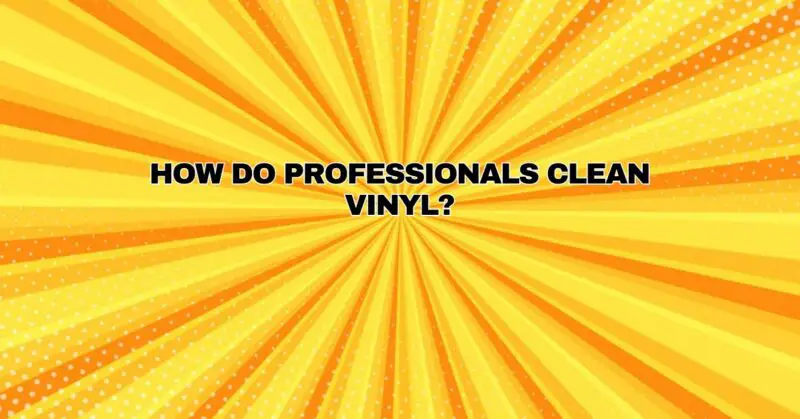Vinyl records, celebrated for their rich analog sound and tactile appeal, continue to captivate audiophiles and music enthusiasts worldwide. To preserve and enjoy the full potential of vinyl records, proper cleaning is essential. Professionals in the music industry have honed their techniques over the years to ensure that records are cleaned meticulously without causing damage. In this article, we will delve into the methods and secrets professionals use to clean vinyl records effectively.
The Importance of Cleaning Vinyl Records
Before diving into professional cleaning techniques, it’s crucial to understand why cleaning vinyl records is necessary. Over time, records accumulate dust, dirt, oils, and even microscopic particles that can affect sound quality and cause audible noise and pops. Proper cleaning not only enhances audio fidelity but also prolongs the life of your records and stylus (turntable needle).
Professional Vinyl Record Cleaning Techniques
- Preliminary Dusting: Before any wet cleaning begins, professionals employ an anti-static brush or carbon fiber brush to remove loose dust and debris from the record’s surface. This initial step helps prevent dirt from smearing or scratching the vinyl during wet cleaning.
- Record Cleaning Machine (RCM): Professional-grade RCMs are the backbone of professional vinyl cleaning. These machines use a combination of a cleaning fluid, a vacuum system, and rotating brushes or pads to remove contaminants from the grooves. Here’s how they work:a. Cleaning Fluid Application: A cleaning solution is evenly applied to the record’s surface, breaking down dirt and oils.
b. Brushing or Pad Cleaning: The machine uses brushes or pads to agitate and loosen contaminants within the grooves gently.
c. Vacuum Extraction: A powerful vacuum system simultaneously extracts the cleaning fluid and contaminants from the grooves, leaving the record clean and dry.
- Cleaning Solutions: Professional cleaning solutions are carefully formulated to be effective at removing contaminants while remaining safe for vinyl records. These solutions often include surfactants that break down oils and dirt, as well as anti-static properties to minimize static buildup.
- Manual Cleaning for Stubborn Stains: In cases where a record requires additional attention due to stubborn stains or grime, professionals may resort to manual cleaning. This involves applying a specialized cleaning solution and using a soft, lint-free cloth or a microfiber brush to gently clean the surface.
- Ultrasonic Cleaning: Some high-end professional setups incorporate ultrasonic cleaning. Ultrasonic baths use high-frequency sound waves to create tiny bubbles that implode upon contact with the record’s surface, dislodging contaminants. This method is especially effective for removing deeply embedded dirt.
- Drying and Storage: After cleaning, records are allowed to air dry vertically to prevent watermarks or streaks. Professionals store cleaned records in anti-static inner and outer sleeves, ensuring they remain in optimal condition.
- Regular Maintenance: Professionals emphasize the importance of regular maintenance. Records are cleaned before and after each play to prevent buildup of contaminants and ensure a pristine listening experience.
Tips for DIY Vinyl Cleaning
While professional-grade equipment offers the most comprehensive cleaning, there are steps that enthusiasts can take to clean vinyl records effectively at home:
- Invest in a Quality RCM: If your budget allows, consider investing in a record cleaning machine designed for home use. There are affordable options that offer significant improvements over manual cleaning methods.
- Use a Reliable Cleaning Solution: Choose a specialized vinyl record cleaning solution designed to break down dirt and oils without harming the vinyl. Avoid alcohol-based solutions.
- Anti-Static Brush: Purchase a good-quality anti-static brush or carbon fiber brush to remove loose debris before each play.
- Manual Cleaning: For stubborn stains or when using an RCM isn’t an option, perform manual cleaning with care, using a soft cloth or brush and a suitable cleaning solution.
- Store Records Properly: Maintain a clean, dust-free storage environment, and use inner and outer sleeves to protect your records.
Conclusion
Professional vinyl record cleaning techniques have evolved over time to ensure that records remain in pristine condition, providing a superior listening experience while prolonging their lifespan. While professional-grade equipment offers the most comprehensive cleaning, enthusiasts can achieve excellent results with home setups, provided they follow best practices and use appropriate cleaning solutions and tools.
Whether you choose to embrace professional methods or opt for DIY cleaning, the key is to make vinyl record cleaning a regular part of your listening routine. By doing so, you’ll not only preserve your record collection but also ensure that each playback delivers the warm, analog sound that vinyl enthusiasts cherish.


